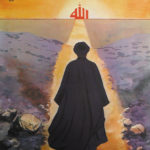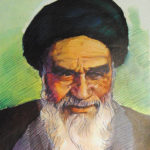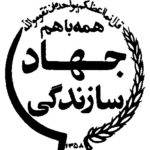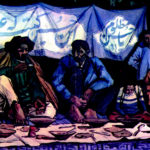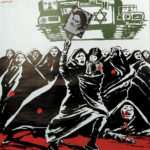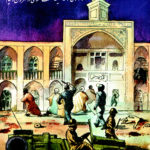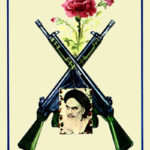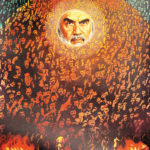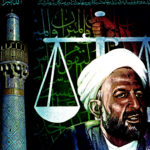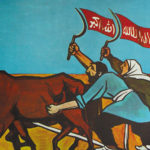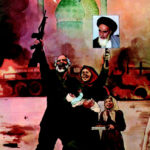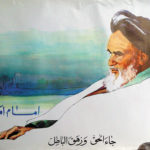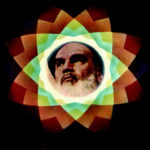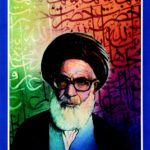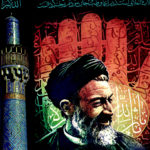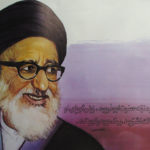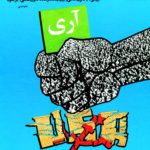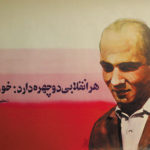Rohani Mashhadi: Artist, Scholar, Revolutionary – A Biography
September 17th, 2016

Mohammad Mahdi Rohani was born in 1947 in Mashhad and began his career in art in 1959. At first most of his paintings were about rural life and nature, but later changed to political and social issues after he gained interest in Imam Khomeini’s movement in 1963. One of the first people who encouraged him to continue art, was his mentor Mohammad Reza Karimi. Rohani held painting and calligraphy courses in Mashhad in 1966 and exhibited one of his paintings, which received a lot of attention, in a gallery.
In 1969, he was accepted in Sharif University to study industrial engineering, continuing to practice his art during his studies. Two years later he set up an exhibition at university with the help of other students and displayed some of his paintings: What’s the World’s Workers Strike? Demonstration of Political Prisoners’ Wives, Life in the Anzali Salt Lake, Unemployed Workers and several more. Mohammad Reza Pahlavi, the then-King of Iran, visited this exhibition and became furious. Rohani was then reprimanded by the Dean of Sharif University and Hoveyda, the then-Prime Minister. He was later arrested, sent to prison, and released 7 months later, but the time he spent in prison was a chance for him to think more about the social state of his country and how he could use his art to portray it. After his release he became more willing to continue his activities.
After he graduated, he became a faculty member of Sharif University and began teaching. During that time, he painted a portrait of the university’s canteen and added symbolic portraits of revolutionary figures there. A few months before the Revolution, he designed posters for the Revolution and distributed them among the student body.
After the Revolution, he joined the Jihad of construction organization which was founded by university students to help farmers and deprived people in villages, constructing homes and facilities in deprived regions. Right after Imam Khomeini commissioned the establishment of the organization, Rohani, inspired by the Imam’s speech, quickly designed a logo for the organization. He formed a graphic design department in the organization and became in charge of it.
When asked to compare his art before and after the Revolution, he said: “in the past, my style was oil painting but I later changed it to graphics. Before the Revolution, graphic arts were only for intellectuals and elites in the cities, and they at most dealt with labor. But later, designing posters and graphic content gained popularity even among villagers. Art left its abstract form little by little and became an art to serve society and the people. I have noticed many art designs in villages, mosques or passageways.”
His first exhibition was held in 1987 in Mashhad’s Chamber of Commerce. Later on 91,92 and 96, he exhibited some of his paintings at Sharif University. In 79, Rohani and some other graphic artists from the Artistic Center, displayed their works at the Museum of Contemporary Art in Tehran. His artworks were also shown at the Literature and Art Gallery of Jihad of construction in 1988 and 1987.
- Nomads and Revolution
- National Army
- Sheikh Fazlullah Nouri
- Martyr Ayatollah Mohammad Beheshti
- The Path of oppresed to fight is One Towards God
- Imam Khomeini
- Jihad of Construction logo
- Like Father Like Son
- Farmers also Have Trenches of their Own to Fight From
- Be Wary of Those Less Fortunate
- Jihad of Construction – Returning to the village
- Our Martyrs Are An Extension of the Martyrs of Karbala
- God is a worker : Jihad in Another Form
- Toppling the American Myth
- The Dawn of the Islamic Revolution
- Farmers Are No Different than Combatants on the Front
- Love, Defense, Faith
- Workers’ Day
- Revolting Under the Guidance of Imam Khomeini
- Braving Adversities Under the Watchful Eye of Imam Khomeini
- Volunteer in the Rebuilding of Deprived Regions
- Martyr Ali Qoddoosi
- Farming is its own Jihad
- Hard Work and Islamic Ethics
- The 1963 Uprising
- Voting to End the White House’s Reign
- Defending the Homeland
- The Imam Has Arrived
- Jihad of Construction Year 1361 Solar Calendar (1981-1982)
- Martyr Seyyed Abd-ul-Hussein Dastghaib
- Local councils
- Mohammad Montazeri
- Freedom
- Martyr Seyyed Mohammad Beheshti
- Ayatollah Taleqani
- Martyrs Rajai and Bahonar
- Straight From the Horse’s Mouse
- Neither East Nor West
- Martyr Ayatollah Morteza Motahhari
- Every Revolutionary Has Two Distinguishing Features: Blood and Message (Dr. Ali Shariati)




